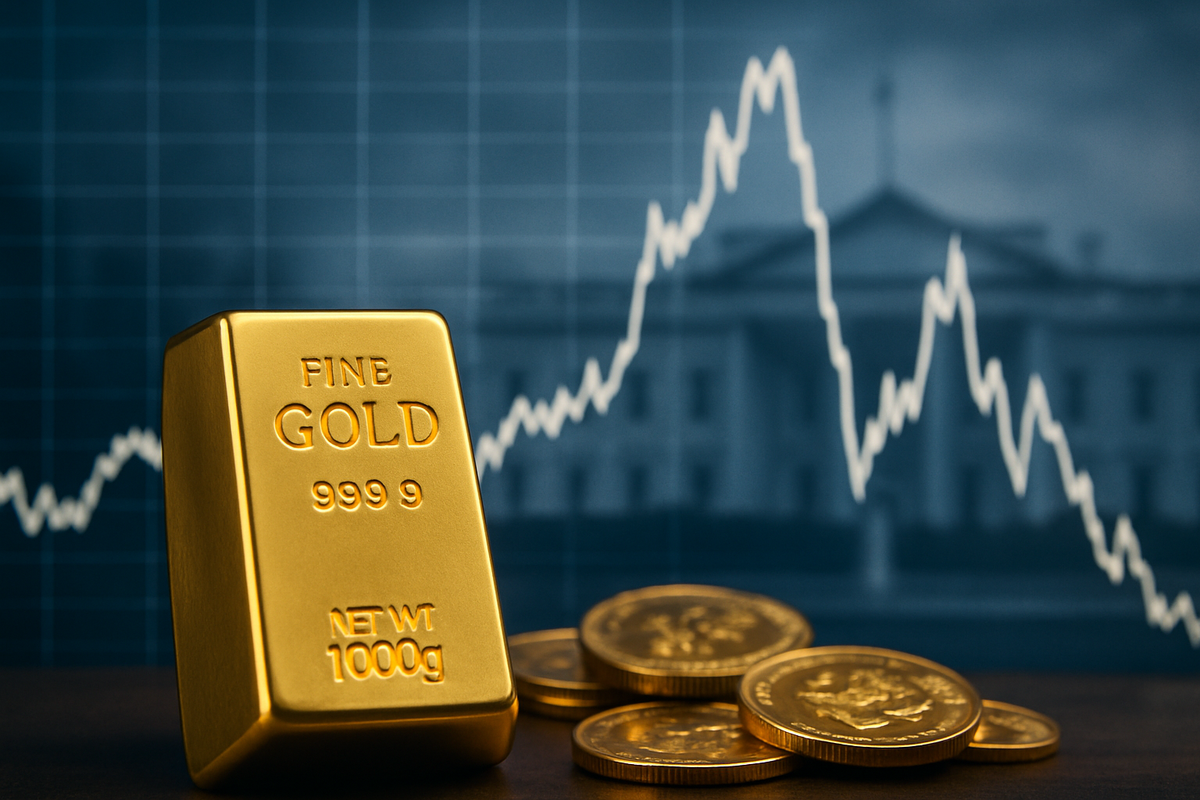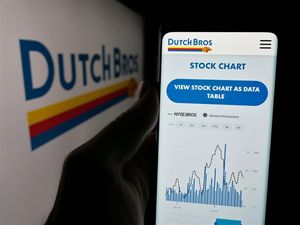
Gold prices experienced a dramatic surge and subsequent pullback on August 8, 2025, as the precious metal first soared to an unprecedented high on fears of new U.S. import tariffs, only to retreat swiftly following a clarifying statement from the White House. This sudden volatility underscored the profound sensitivity of the gold market to trade policy uncertainty and official government pronouncements, sending ripples through global financial markets and highlighting the unpredictable nature of safe-haven assets in an era of shifting geopolitical landscapes.
What Happened and Why It Matters
The day began with U.S. gold futures (COMEX: GC=F) hitting an all-time high, briefly touching just over $3,534 per troy ounce, while spot gold (XAU=) also reached a record of $3,487.90 per ounce. This rapid ascent was ignited by a report from the Financial Times, which cited a July 31 ruling letter from U.S. Customs and Border Protection (CBP). The letter reportedly indicated that one-kilo and 100-ounce gold bars would be subject to new U.S. import tariffs, a development that came as a "huge surprise" to the market. Bullion had previously been widely understood to be exempt from President Donald Trump's broader tariff policies.
The reclassification of these gold bars from "unwrought" to "semi-manufactured" under U.S. International Trade Commission definitions carried significant tariff implications. Given that one-kilo bars are the most commonly traded format on Comex, the world's largest gold futures market, and a substantial portion originates from Switzerland (which faced a potential 39% tariff), the prospect of these levies created immediate market turmoil and uncertainty in global bullion trade. Analysts noted that this was "precisely what the market feared," demonstrating that even safe-haven assets like gold are vulnerable to the volatility unleashed by trade policy confusion. In response to the uncertainty, some gold refineries, including a major Swiss entity, temporarily halted deliveries of bullion to the United States, further exacerbating supply chain concerns.
However, the record high was short-lived. Shortly after the initial surge, the White House moved to clarify the situation. An anonymous official informed Bloomberg that the White House planned to issue an executive order to clarify that imports of gold bars would not face tariffs, dismissing the earlier reports as "misinformation." The immediate market reaction to this clarification was a swift pullback in gold prices. Both spot gold and futures prices on New York's Comex fell, paring their earlier gains. This demonstrated how quickly the market reacted to official communication, reversing the "panic ascent" that had been driven by the initial tariff reports. The episode underscored the significant influence of U.S. trade policy announcements and subsequent clarifications on the highly sensitive gold market, leading to rapid price swings as traders adjusted their positions based on evolving information.
Winners and Losers in Gold's Volatile Dance
The recent dramatic swings in gold prices have created a clear delineation of potential winners and losers across the precious metals industry, impacting mining companies, refiners, and investment firms alike. The immediate aftermath of the tariff scare and subsequent clarification highlighted the inherent leverage and risks associated with each segment.
Gold Mining Companies: For gold mining companies, the initial surge in prices was a boon, as higher gold prices directly translate to expanded profit margins and increased cash flows. Companies with low All-in Sustaining Costs (AISC) per ounce, such as Alamos Gold (TSX: AGI), are particularly well-positioned to capitalize on such price increases, as their profitability can increase disproportionately to the rise in gold prices. Miners with strong balance sheets and low debt levels also stand to benefit, as they can better weather volatility and potentially fund exploration or increase shareholder returns. Conversely, high-cost producers or those with significant debt burdens face considerable risk during price pullbacks, as their margins can quickly erode, potentially leading to financial strain or even mine closures. Companies operating in politically unstable regions also face heightened risks from regulatory changes or nationalization efforts, which can undermine profitability regardless of gold prices.
Gold Refiners: Gold refiners primarily generate revenue from processing raw gold into purer forms, charging a fee based on volume rather than the fluctuating price of gold itself. During periods of increased mining activity or heightened demand for physical gold, refiners with high throughput capacity stand to gain from increased processing volumes. The initial tariff scare, while short-lived, also highlighted a potential scenario where domestic refiners in the U.S. could have seen increased demand if tariffs had made international imports less attractive, forcing more domestic processing. However, refiners dependent on specific supply sources or those with high operational costs could face challenges if price volatility leads to disruptions in mining operations or trade routes, reducing feedstock and utilization rates.
Investment Firms: Investment firms dealing with gold are significantly affected by price volatility, as it influences investor behavior and product demand. Firms offering gold-backed Exchange Traded Funds (ETFs) and other gold-related investment products, such as the SPDR Gold Shares (NYSEARCA: GLD), tend to see increased inflows of capital during periods of market uncertainty and economic instability, as investors seek gold as a safe-haven asset. The initial tariff scare, by increasing uncertainty, likely spurred some immediate demand for these products. Firms specializing in precious metals trading can also profit from increased trading volume and price swings through arbitrage opportunities and speculative positions. However, firms with significant exposure to gold mining equities without proper risk management can face substantial losses during sharp price corrections, as mining stocks often exhibit higher volatility than physical gold. Similarly, firms under-allocated to gold during bull markets may miss out on significant returns and the diversification benefits that gold provides.
Industry Impact and Broader Implications
The recent gold price volatility is not an isolated event but rather a symptom of broader industry trends and macroeconomic forces. Gold's role as a safe-haven asset means its price often reflects global economic uncertainty, geopolitical tensions, and inflation concerns. The initial surge underscored the market's sensitivity to trade policy, a recurring theme in recent years, while the swift pullback highlighted the power of official government communication in shaping market sentiment.
This event fits into a broader trend of increased demand for gold as a hedge against inflation and currency devaluation, particularly in an environment of persistent global economic uncertainty and central bank policies aimed at diversifying away from the U.S. dollar. Many central banks, notably in China, India, and Turkey, have been steadily increasing their gold reserves, creating a structural demand that provides underlying support for gold prices even amidst short-term volatility. The reclassification of gold as a Tier 1 asset under Basel III regulations also has long-term implications, potentially leading to a significant upward repricing of gold as banks are required to maintain 100% backing for gold positions.
The ripple effects extend beyond the immediate financial markets. In the mining sector, sustained high gold prices incentivize increased exploration budgets and investment in new projects, potentially leading to future production growth. However, operational costs and geopolitical instability in mining regions remain significant challenges. For the jewelry industry, volatility can lead to a "wait and watch" approach from consumers, impacting sales and manufacturing strategies. While luxury jewelry manufacturers may continue to use more gold due to strong customer demand, there's also a trend towards focusing on timeless, high-quality designs and a shift towards lower karat gold for core collections in some markets.
Historically, gold has demonstrated its safe-haven role during periods of significant global upheaval. The 1970s stagflation, the 2008 Global Financial Crisis, and the COVID-19 pandemic all saw gold prices surge as investors sought refuge from economic turmoil. The current environment, characterized by ongoing geopolitical tensions, trade disputes, and inflation concerns, draws parallels to these historical precedents, reinforcing gold's traditional role as a store of value. The brief tariff scare served as a stark reminder of how quickly policy decisions can disrupt global supply chains and create market dislocations, impacting not only gold but also other commodities and financial instruments.
What Comes Next
The recent volatility in gold prices, while jarring, offers a glimpse into the likely trajectory of the precious metal in the coming months and years. In the short term, gold is expected to remain strong, with some analysts predicting new all-time highs. Factors such as anticipated U.S. monetary easing, a potentially weaker U.S. dollar, and ongoing geopolitical uncertainty will continue to provide significant support for gold's appeal as a non-yielding safe-haven asset. Short-term price swings will likely be influenced by market sentiment, technical analysis, and speculative trading, making it crucial for investors to remain agile.
Looking further ahead, the long-term outlook for gold prices is predominantly bullish. Projections from various institutions suggest significant appreciation over the next few years, with some forecasts indicating gold could reach or exceed $5,000 per ounce by 2030. This optimistic outlook is underpinned by several key drivers: persistent global inflation concerns, continued strong central bank demand for gold as a reserve asset, and gold's enduring role as a safe haven during economic slowdowns and crises. Furthermore, declining mining production due to the scarcity of new deposits, increasing extraction difficulties, and rising costs are expected to constrain supply, contributing to tighter markets and higher prices.
For investors, a long-term perspective is advised, viewing any short-term corrections as potential buying opportunities within an intact bull market. Gold's role as a portfolio diversifier, especially when returns on other assets are subdued, remains critical. Investors should closely monitor macroeconomic indicators, central bank policies, and geopolitical developments to make informed decisions. For the gold mining industry, strategic pivots will be essential. This includes investing in technological innovation to access deeper or previously uneconomic deposits, adopting more sustainable practices to address environmental concerns, and navigating complex regulatory and political landscapes in mining regions. Managing escalating production costs will also be critical to ensure profitability and better valuations.
Potential scenarios for gold's future include a continued bullish trend driven by persistent inflation and geopolitical tensions, or an accelerated bull market if global crises escalate significantly. While bearish corrections are always possible due to factors like a stronger U.S. dollar or a robust stock market, many analysts view such pullbacks as healthy consolidations that create a stronger foundation for future advances.
Conclusion
The recent dramatic surge and subsequent pullback in gold prices served as a powerful reminder of the precious metal's sensitivity to global economic and political developments. The initial tariff scare, though quickly clarified, highlighted the market's vulnerability to trade policy uncertainty, while the swift reversal underscored the immediate impact of official government communication. This event reinforces gold's enduring role as a safe-haven asset, a characteristic that becomes increasingly prominent during periods of heightened global uncertainty and inflation concerns.
Moving forward, the consensus points to a positive trajectory for gold prices in the coming years. Its traditional function as a hedge against inflation and a store of value, coupled with robust central bank demand and anticipated supply constraints from the mining sector, is expected to drive continued appreciation. Investors should recognize gold's value as a portfolio diversifier and remain attuned to macroeconomic shifts, central bank actions, and geopolitical events.
The gold market will likely remain dynamic, presenting both opportunities and challenges. While short-term volatility is to be expected, the underlying fundamentals suggest that gold will continue to be a crucial asset in the global financial landscape. Investors should watch for further developments in trade policies, central bank interest rate decisions, and the evolution of global geopolitical tensions, as these factors will continue to shape gold's path in the months and years to come. The recent "wild ride" in gold prices is not an anomaly but rather a preview of the complex interplay of forces that will continue to define its market.





